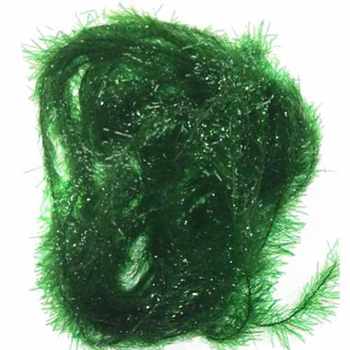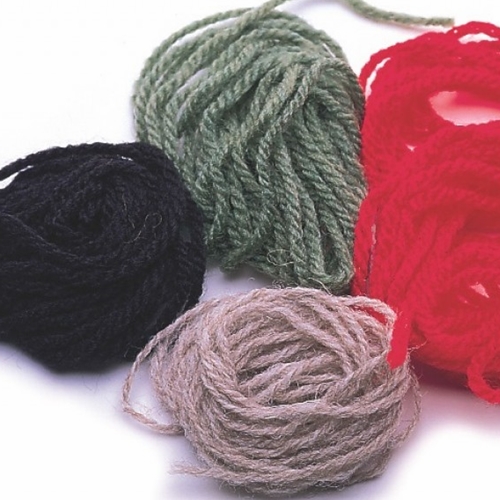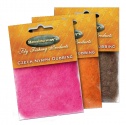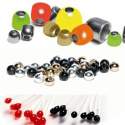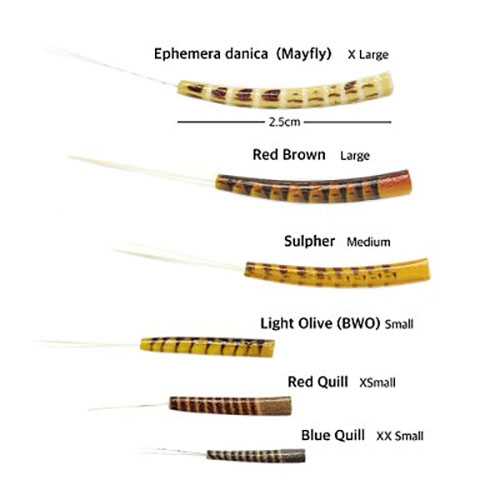An Introduction to Fly Tying Tools Buy Here From
Fly Tying Tools In UK For Sale
Of all of the ways to catch fish, there are few are as exciting and rewarding as catching a fish on a fly that you have tied yourself. An artificial fly can entice the slow rise of a trout, gentle sip of a grayling, huge run of a Muskie or explosive strike of a largemouth bass. For many fly fishermen tying flies is as satisfying as landing the fish.
The art of fly tying is the craft of combing a few basic elements on a fly, that of the tail, body wing and hackle to create the final artificial fly. It can be achieved with just a few basic materials like wool, fly tying fur, fly tying feathers and thread or silks and a few simple tools. Once you have learned the basics of fly tying you will find many patterns that are simple to tie. The simple tools a fly tyer will utilize basic fly tying tools include a fly tying vice, bobbins, scissors, hackle pliers, hair stackers.
Fly Tying Vices
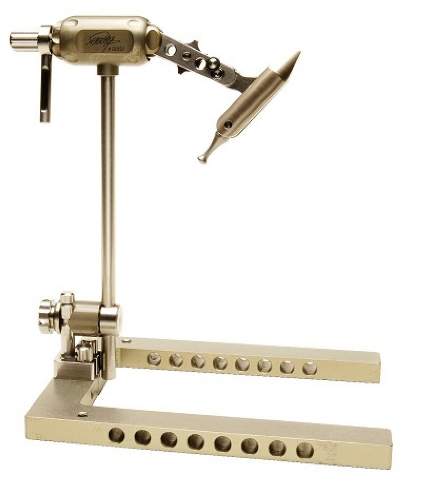 While it is possible to hold the hook with your fingers and it is amazing to watch old traditional fly tyers tying dressed salmon flies entirely by hand however this is not normal today, with hooks going down to size 24 or even 32 the majority of fly tyers would not dream of tying a fly and not using a vice. A good fly tying vice will be easy to use, hold the hook securely and adjust to a wide range of hook sizes. Actions on vices include lever action which is sufficient for most tyers, however for large pike, bass or saltwater patterns a spring loaded vice may be used. Normally fly tyers prefer a simple lever action that is pressed down once after the jaws have been adjusted to suit that size of hook. The jaws should be hard tempered in order to withstand many years of wear. Vices come with C Clamps which attach to your desk or tying surface or alternatively pedestal models, good vices may have both options . Pedestals need to be heavy enough so that they stay in one place as you tie. These are generally less portable than C Clamp vices because of the weight in the base. Vices may frequently have replaceable heads allowing different types of hooks to be connected. Specialist attachments may be available for tube flies tying. Finally you can get small streamside vices, very small vices that you use at the river bank to match the hatch.
While it is possible to hold the hook with your fingers and it is amazing to watch old traditional fly tyers tying dressed salmon flies entirely by hand however this is not normal today, with hooks going down to size 24 or even 32 the majority of fly tyers would not dream of tying a fly and not using a vice. A good fly tying vice will be easy to use, hold the hook securely and adjust to a wide range of hook sizes. Actions on vices include lever action which is sufficient for most tyers, however for large pike, bass or saltwater patterns a spring loaded vice may be used. Normally fly tyers prefer a simple lever action that is pressed down once after the jaws have been adjusted to suit that size of hook. The jaws should be hard tempered in order to withstand many years of wear. Vices come with C Clamps which attach to your desk or tying surface or alternatively pedestal models, good vices may have both options . Pedestals need to be heavy enough so that they stay in one place as you tie. These are generally less portable than C Clamp vices because of the weight in the base. Vices may frequently have replaceable heads allowing different types of hooks to be connected. Specialist attachments may be available for tube flies tying. Finally you can get small streamside vices, very small vices that you use at the river bank to match the hatch.
Bobbin Holders
Ceramic Bobbin Holder
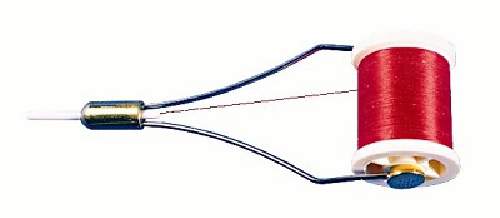 While it is possible to tie a fly by removing a length of tying thread from its spool there are many advantages to using a Bobbin Holder, ranging from reducing wastage to keeping tension. So the Bobbin Holder performs more functions than are apparent at first sight. Not only does a bobbin hold the spool of thread or silk as you tie, it maintains the tension on the fly being tied so furs and feathers do not spring
While it is possible to tie a fly by removing a length of tying thread from its spool there are many advantages to using a Bobbin Holder, ranging from reducing wastage to keeping tension. So the Bobbin Holder performs more functions than are apparent at first sight. Not only does a bobbin hold the spool of thread or silk as you tie, it maintains the tension on the fly being tied so furs and feathers do not spring 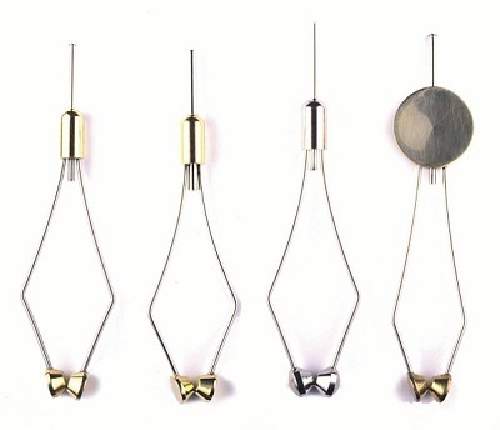 loose. Whenever you pause the bobbin simply hangs below the hook with the weight of the bobbin stopping the fly from unravelling. Additionally bobbins can be spun tightening the thread so that the thread or more modern tying silks like Semperfli Nano Silk which is a form of Gel Spun Polyethylene which is virtually unbreakable yet has extremely thin diameter equivalent to a 12/0 or 50 denier silk. It is small enough not to create build up on the smallest Klinkhammers or other flies. Bobbins come with brass, plastic or for modern silks like Semperfli with ceramic tubes through which the thread the silk.
loose. Whenever you pause the bobbin simply hangs below the hook with the weight of the bobbin stopping the fly from unravelling. Additionally bobbins can be spun tightening the thread so that the thread or more modern tying silks like Semperfli Nano Silk which is a form of Gel Spun Polyethylene which is virtually unbreakable yet has extremely thin diameter equivalent to a 12/0 or 50 denier silk. It is small enough not to create build up on the smallest Klinkhammers or other flies. Bobbins come with brass, plastic or for modern silks like Semperfli with ceramic tubes through which the thread the silk.
Bobbin Wire Loop Tool
A Bobbin wire loop tool is extremely simple. Put your silk thread on its spool into the bobbin holder. Now simply push through the bobbin holder tube, slip the thread through the wire loop tool and retrieve the tool through the bobbin holder tube and your thread is ready for tying. Many people suck the thread through the bobbin tube but the wire loop tool makes this an extremely simple process!
Scissors
Scissors
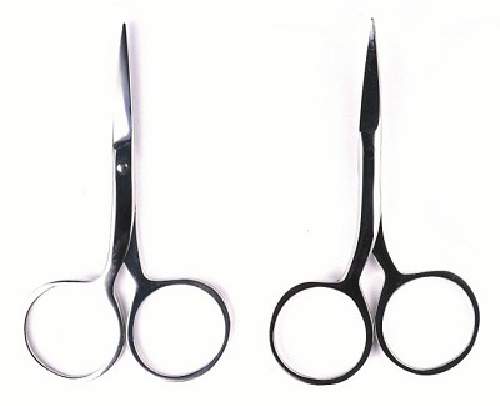 A fly tyer will have a range of different scissors for fly tying. Key is that they are extremely sharp and have a very fine point for close-up work. Scissors will be generally smaller than used by craft or domestic users. Tungsten blades are available which are excellent. The blades on scissors can be straight, curved or serrated according to the cutting requirements. Typically fly tyers keep two pairs of scissors handy, one as a workhorse to cut through tough materials like feather stalks, hair and tinsel and a second pair for delicate tasks like trimming hackle, thie second pair usually having smaller finer points. Generally it is worth keeping a razor blade handy also, especially if using some of the modern Kevlar or gel spun silks available, frequently these are tougher than the scissors!
A fly tyer will have a range of different scissors for fly tying. Key is that they are extremely sharp and have a very fine point for close-up work. Scissors will be generally smaller than used by craft or domestic users. Tungsten blades are available which are excellent. The blades on scissors can be straight, curved or serrated according to the cutting requirements. Typically fly tyers keep two pairs of scissors handy, one as a workhorse to cut through tough materials like feather stalks, hair and tinsel and a second pair for delicate tasks like trimming hackle, thie second pair usually having smaller finer points. Generally it is worth keeping a razor blade handy also, especially if using some of the modern Kevlar or gel spun silks available, frequently these are tougher than the scissors!
Hackle Pliers
Hackle Pliers
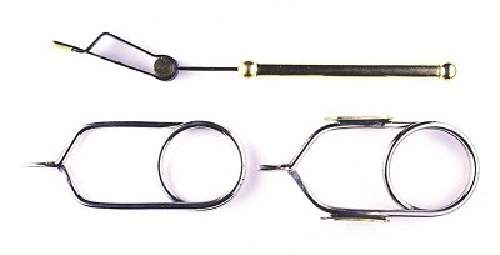 Hackle pliers simplify the job of winding hackle. A set of Hackle Pliers will grasp the hackle tip firmly without slipping. The jaws should be smooth as rough surfaces could cut the hackle while winging. If the hackle pliers are cutting too many hackle tips then consider dulling the edges with a fine matal file or even a hook honer. There are different shapes of hackle pliers including traditional English, teardrop, rotating all have the same purpose of helping you wrap the hackle around the hook.
Hackle pliers simplify the job of winding hackle. A set of Hackle Pliers will grasp the hackle tip firmly without slipping. The jaws should be smooth as rough surfaces could cut the hackle while winging. If the hackle pliers are cutting too many hackle tips then consider dulling the edges with a fine matal file or even a hook honer. There are different shapes of hackle pliers including traditional English, teardrop, rotating all have the same purpose of helping you wrap the hackle around the hook.
Hair Stackers
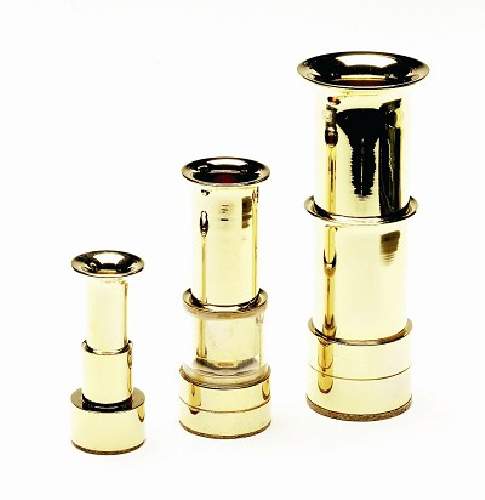 A hair stacker is an essential tool which allows alignment of many different types of fibres, including naturals like elk hair and synthetics. Hair stackers come in different sizes ranging from small to magnum typically used for aligning larger bundles of hair for bass bugs, saltwater lures or pike lures. To use a hair stacker put a small clump of hair into the funnel tips first. Tap the stacker firmly against a hard surface or bench several times. The tapping aligns all of the tips. Remover the funnel and grasp the tops of the hair fibres carefully, all of the tips should now be perfectly aligned for tying.
A hair stacker is an essential tool which allows alignment of many different types of fibres, including naturals like elk hair and synthetics. Hair stackers come in different sizes ranging from small to magnum typically used for aligning larger bundles of hair for bass bugs, saltwater lures or pike lures. To use a hair stacker put a small clump of hair into the funnel tips first. Tap the stacker firmly against a hard surface or bench several times. The tapping aligns all of the tips. Remover the funnel and grasp the tops of the hair fibres carefully, all of the tips should now be perfectly aligned for tying.
Dubbing Needles or Bodkins
Dubbing needles for combing of underfur, applying head cement and teasing dubbed materials, dividing wing tips and freeing trapped hackle fibres.
Whip Finish Tools
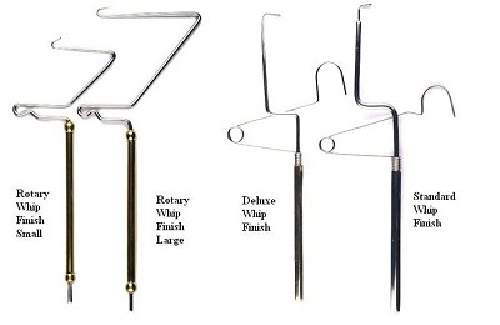 It is perfectly possible to whip finish a fly with fingers alone, however many tyers find using a specially made tool beneficial. Models vary but generally most whip finish tools have a straight handle with a hook at one end with often a sprung wire arm.
It is perfectly possible to whip finish a fly with fingers alone, however many tyers find using a specially made tool beneficial. Models vary but generally most whip finish tools have a straight handle with a hook at one end with often a sprung wire arm.
Dubbing Twister
A dubbing twister is a great tools for creating dubbing loops twisting dubbing and threads into a rope which can then be easily wound around a hook. Dubbing Twisters keep the tension on the thread loop to keep the fur in position. With sprung metal arms and a heavy circular body a Dubbing Twister keeps the thread taught.
Other Useful Fly Tying Tools
Other useful fly tying tools include; tweezers for holding small materials, small pliers for de-barbing hooks. Finally organisers are always useful as you tend to gather lots of small materials and bobbins with thread, chenilles and other materials.





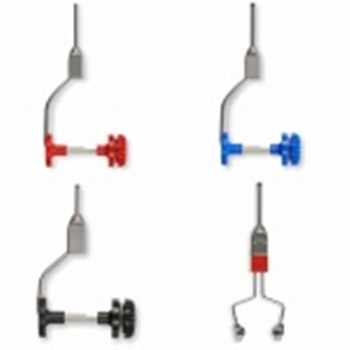
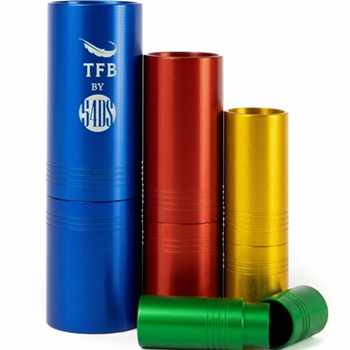
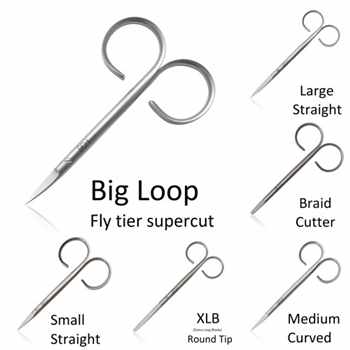
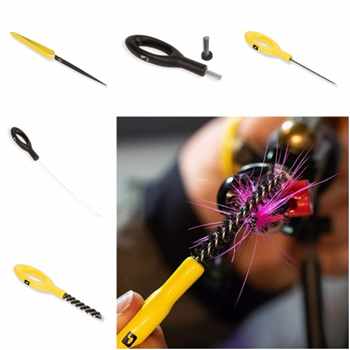
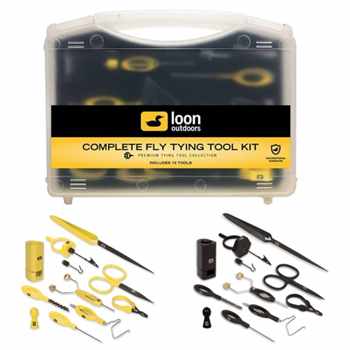
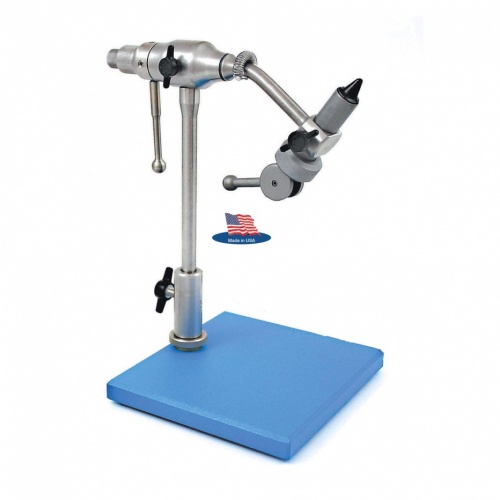
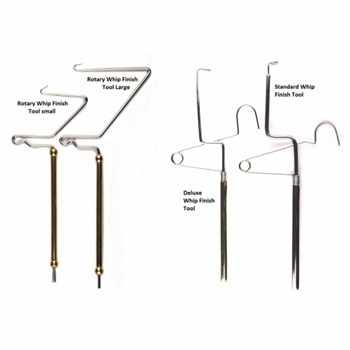
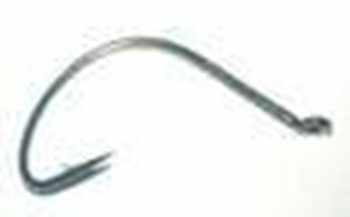
.jpg)



